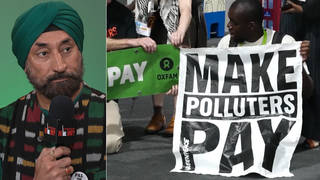
Topics
Perhaps no other radical historian has reached so many hearts and minds as Howard Zinn. His book, A People’s History of the United States, has gone into more than 25 printings and sold over 400,000 copies. It is rare that a historian of popular movements has managed to retain as much credibility while refusing to let his academic mantle change his writing and teaching style from being anything but direct, forthright and accessible. [includes rush transcript]
Tape:
- Howard Zinn, professor emeritus of political science at Boston University and the author of 14 books, including A People’s History of the United States, Postwar America and You Can’t Be Neutral on a Moving Train.
Transcript
AMY GOODMAN: Today is Columbus Day and, in some quarters, Indigenous People’s Day. To mark the day, we’re going to—on a journey through American history with scholar and activist Howard Zinn. Perhaps no other radical historian has reached so many hearts and minds as Howard Zinn. His book, A People’s History of the United States, has gone into more than 25 printings and sold close to a half-a-million copies. It’s rare that a historian of popular movements has managed to retain as much credibility while refusing to let his academic mantle change his writing and teaching style from being anything but direct, forthright and accessible. For the next two segments of today’s show, we’ll hear a speech recently given by professor emeritus of Boston University, Howard Zinn.
HOWARD ZINN: Some of you may know George Orwell’s statement about history: whoever controls the past controls the future, and whoever controls the present controls the past. And whoever’s in charge of a culture decides what history we get, or tries to decide what history we get, and our job is to look beyond that and to try to find our own history, the one that they don’t want us to have. You know what I mean by “they.” I won’t—I won’t give you any names, but there is—there’s always a “they.”
And I never believed in doing disinterested history. I didn’t believe it was possible to do disinterested history. History always represents interests, of one sort or another. History always has an effect. You can take some simple historical—very simple historical statements and just think of the effect they had. You know, here is a historical statement. Imagine, “The Jews killed Christ.” Tell that—give that historical statement to a six-year-old kid, right? That’s going to have an effect. Or to a 16-year-old kid who is going to high school, discuss the Reconstruction period and say—give him some history and give him some facts and tell him that when the black people were—after the Civil War, were given the right to vote and were given the right to do other things, they ran wild, they ran amok. I always like that word, amok. And they—and when they were elected to the legislatures, they were just corrupt, and they ruined everything, because, as you know, we never had corrupt legislatures, until blacks got into the legislatures. You can imagine the effect on a 16-year-old hearing that, but, you know—I mean, make the connection between that and the things you hear today about, “We’ve given them too much,” right? You give them a little—you’ve heard that—and look what they do. So, I think it’s very clear, I think, to anybody who thinks for a while about history, the impossibility of history being disinterested, no matter how disinterested it looks, no matter how fat the textbook. Sometimes people think that if the textbook is fat, it must have all there is. And if there seems to be no expression of opinion, there’s no—it’s objective, and it’s neutral. And, of course, any textbook, however fat, is a selection of facts out of an infinite number of facts.
I wasn’t always a historian. I wasn’t born a historian. I had grown up in a working-class family and become aware very early of—let’s put it this way: I became class-conscious early. I had to hesitate before saying that, because the word “class,” you know, is not a word—in election campaigns, you hear candidates accuse one another of raising the class issue. I remember Bush accused Dukakis of invoking class hatred. I couldn’t imagine Dukakis doing that, actually. I couldn’t imagine Dukakis doing anything, you see, and certainly not invoking class hatred, you see? But yes, I became class-conscious at an early age. And I didn’t know I was class-conscious. If you would have asked me, “Are you class-conscious?” “I don’t know what you’re talking about.” But I was aware of—I was aware, looking around me and looking at my life and the life of my parents—my parents were European immigrants who—and we lived in, you know, the slums of Brooklyn, and my father—and what I did see and what did register with me is that my father worked very hard, and he had nothing to show for it.
And from that—and I understood that, and I knew—although I didn’t encounter these people personally, I knew there were people in the society—I could see them in the news, you see. I knew there were people who were very, very rich. And it wasn’t very clear to me what they did, or if they did anything, or if they did anything useful. So I knew, from the beginning, that what they call the “American Dream,” you know, and you worked—from that point on, whenever anybody said to me, “Oh, in America, if you work hard, you’ll make it” — when I was teaching at Boston University and a lot of my students were upper-middle-class students, came from very successful families, you know, business people, professional people, and—no, not all the sons and daughters of such families absorb that ideology of, you know, the Horatio Alger ideology. The biggest conflicts in my class, and always, you know, ideological conflicts in my class—the biggest conflicts were over the class issue. And there were always the students who said, you know, “My grandfather started from here, and now my family is well off,” you know? “And if you work hard, you will make it.” I always was indignant when I heard that statement, because I knew how untrue it was. So, yeah, you might say I—that was an interest of mine, all through my life.
At the age of 18, I went to work in a shipyard instead of going to college. I say that as if I did it as a sociological experiment. But not that I—I just—I became a shipyard worker at the age of 18 and worked for three years in a shipyard, and if I had any class-consciousness to begin with, it was, I guess, reinforced by working very hard, not making much, and seeing people work under very dangerous and unhealthy conditions, which weren’t paid much attention to, and thinking that these people are going to die earlier than other people who don’t work under these conditions. And you’ve probably read at some point about shipyard workers inhaling asbestos and dying early. And, you know, when you work in a shipyard, you’re inhaling fumes all the time. We didn’t even know, and nobody told us what we were inhaling, didn’t tell us that if you welded on galvanized steel, that the fumes that came off that were deadly. You know, just—so that was an experience that burned something into me.
And then I enlisted in the Air Force, and I became a bombardier in the Air Force, in World War II. I hesitated to tell you what war I was in, but then I figured if I didn’t tell you what war I was in, you would think I was in the Spanish-American War. So, I was a—I became a bombardier in World War II, and I was an enthusiastic bombardier—the war against fascism and all of that, you know. I really was. And it wasn’t until after the war that I began to think more complexly about that war and about war in general and about what war accomplished—even good wars, and this was, yes, the best of wars.
So, all these experiences were with me when I began to do history. And then, my first teaching job, my first real teaching job—I had a number of unreal teaching jobs—my first real teaching job was in the South, in Atlanta, Georgia. I taught at Spelman College, a college for black women in Atlanta. I taught there for seven years, from 1956 to 1963. You know, those were the years of—those were important years. Those were the years of the civil rights movement and of turmoil, and they were very exciting and still perhaps the most intense experience of my life. And I became involved in the movement. I became a kind of participant, what sociologists call a “participant observer,” or participant writer. I was involved in the movement, and I began writing about it for The Nation and for Harper’s, and became involved with SNCC, the Student Nonviolent Coordinating Committee. And I began to think about history from the black point of view, because it’s hard to live in a black community and teach in a black college without beginning—at least beginning to think of history from a different point of view.
And everything looks different in history when you look at from the black point of view. If you take just something like the Progressive period in American history, anybody who studies history goes through, and there’s always a period called the Progressive Era or the Progressive period in American history, which is the first years of the 20th century, roughly between 1900 and, you know, World War I, the Progressive period. Why is it called the Progressive period? Well, because some reforms were passed, right? The meat inspection—Meat Inspection Act was passed. You notice how good our meat is? Meat Inspection Act, railroad regulation, 16th Amendment, 17th Amendment, Federal Reserve Act—this is what you learned in school, right? You got multiple-choice questions about—to see if you knew the difference between, you know, the Federal Trade Commission and the Federal Reserve Commission. And if you read a black historian, which I read while I was teaching in Spelman College, a black historian named Rayford Logan, who wrote exactly about that period—he didn’t call it the Progressive period, he called it “the nadir,” the bottom. The Progressive period was the period in which more black people were lynched than any other period in American history. And still it continued to be called the Progressive period in American history.
So, from a black point of view, all the presidents of the United States look different. Lincoln looked different. Lincoln suddenly was not, you know, the Great Emancipator represented in that statue with the black kneeling before him gratefully, you know, where Lincoln bestows emancipation. From the black point of view, or from any decent point of view, Lincoln was a reluctant emancipator. Lincoln had to be pushed into it, by a movement, by an anti-slavery movement, by black abolitionists and white abolitionists, by a crescendo of criticism of him for not doing anything about slavery, even while a civil war was going on and even after the South had seceded. You know, Lincoln looks different.
AMY GOODMAN: Professor Howard Zinn, he is a historian, well-known author of more than 14 books, including A People’s History of the United States, Postwar America and You Can’t Be Neutral on a Moving Train. His latest book is called The Zinn Reader: Writings on Disobedience and Democracy. It’s published by an independent press. That’s Seven Stories Press.
In the last segment of today’s show, after we hear more of Professor Howard Zinn’s speech, you’re going to hear from the founders of the Anathoth Community. They’re a community in northern Wisconsin that has been fighting the Navy’s Project ELF. Project ELF stands for Extremely Low Frequency, and it’s the frequency the Navy puts out that, when changed, would signal to Trident submarines to launch a first strike. I had a chance to speak with them when I went out to Minneapolis last weekend to speak with activists throughout that area. So you are listening to Pacifica Radio’s Democracy Now!, heard from Washington state to Florida, from Minneapolis to Maine and many cities in between. We’ll be back in a minute.
[break]
AMY GOODMAN: You’re listening to Pacifica Radio’s Democracy Now! I’m Amy Goodman, as we continue on a journey through American history with historian Howard Zinn, professor emeritus of political science at Boston University, author of many books, including A People’s History of the United States and his latest, The Zinn Reader: Writings on Disobedience and Democracy, published by Seven Stories Press. Howard Zinn.
HOWARD ZINN: Roosevelt looks different. Anybody who has studied FDR fairly closely knows, that Roosevelt, who was, you know, I guess, one of our best presidents, in many, many ways—no question—but Roosevelt would not support the passage of an anti-lynching law in Congress, because he was tied in with the Southern Democrats and dependent on their political support.
Same thing with Kennedy. Kennedy, you know, the liberal president, the young and, you know, we all know the good things about—that everybody believed about Kennedy. But from the point of view of people in the movement, people in the South in the movement in the early 1960s, Kennedy was no civil rights advocate. Kennedy appointed racist segregationist judges in the deep South, in Alabama and Georgia and Mississippi. Kennedy’s Justice Department stood by while people were being beaten, and Kennedy didn’t respond. Same thing with his attorney general, Robert Kennedy. Heroes look different, everything looks different, when you look at it from a different point of view. So all of these things affected my thinking about history.
When I first began to—when I decided to write A People’s History of the United States, and I guess I decided to write it because I was looking for a book like that, and I couldn’t find it. So I wrote it. That very often is why—how books get written. You look around for something, and you think, well, surely something—somebody must have done this, because it’s needed. You know, somebody has to write a history book from a point of view which is different than, you know, what has been done before. I couldn’t find it, so I did it, and I made up my mind that I was going to tell the history of the United States from a different point of view. I was going to tell the story of Columbus from the standpoint of the Indians, because we never got that. The Indians were always—you know, who were they? You know, a blur in history.
I wanted to tell the story of the Mexican War from the standpoint of the Mexicans. It looks different that way. From the American point of view, we won the war, as we always do—well, until recently. But—and it was great! We ended up with California and all of this territory. The Southwest all belonged to Mexico, and we got it. From the point of view of the Mexicans, there was a war instigated by the United States, planned by President Polk even before that incident took place in 1846 between the Nueces River and the Rio Grande River—planned, just as so many—you know, just as the United States wanted the Philippines, and there was an incident just at the right time, and the United States wanted to move into Vietnam, and there was an incident in the Gulf of Tonkin. A lot of manufactured incidents. And so, I just wanted to introduce different points of view.
I wanted to tell the story of the Industrial Revolution in the United States, which I had always learned, and when I went to school, in a very inspiring way. And I remember as a kid, as a high school kid, actually feeling proud that America had become this great industrial power, that period between the Civil War and World War I, the steel mills going up and the—you know, they would give us figures on how much coal was produced this year and how much coal was produced 20 years later, and the railroads spanning the country, and the Transcontinental Railroad being built, and the Union Pacific and the Central Pacific meeting, and the president driving a golden spike through the last—you know, right—rails, and very exciting. And that story is still being told that way, for the most part. And I wanted to tell that story from the standpoint of the people who worked in the steel mills, the people who worked in the mines, the people who worked on the railroads, the Irish immigrants and the Chinese immigrants who were brought in to work on the Transcontinental Railroad and who died by the thousands working in the heat and the cold, getting sick, working long hours and dying of exhaustion. That’s a different point of view about this great Industrial Revolution. It makes you think about all industrial revolutions.
It makes you think about—no, I’m not about to say, “Let’s go back to the cave.” You know, you’re always accused of this when you criticize the way industry has functioned or the way industry has been built or the way—you know, you’re always accused of being—wanting to go back and not having dishwashers, you know. And no, it’s not that. But it’s important to understand, even though you want progress and you want—sure, you want new things to be produced, but it’s important to understand the human cost of that, and whether you must pay that human cost in order to have progress or whether you can have progress without sacrificing human beings.
You know, it’s easiest for us to see when we look at someone else or some other country, some other system. You know, if you went to Russia, you know, there are still people who revere Stalin in the Soviet Union. And if you said, “Well, why do you revere Stalin?” they’d say, “Stalin built up our country. You know, we were nothing. You know, we were 14 in the world, Stalin made us number two. Stalin, you know, he—we had an industrial revolution under Stalin. Oh, yes, he had his faults.” You know.
So, I wanted to put women more into history than they had been and show what part women played in history. I wanted to spend more time on Mother Jones than on Theodore Roosevelt, which is a shocking thing to do. Theodore Roosevelt, one of our great presidents, he’s high on any list of presidents. You know they do these—every once in a while, they do these lists of presidents, you know, top 40 hits and top 10, top five, and there’s this—the top presidents. So Theodore Roosevelt is always somewhere near the top. Tells you something about the historical teaching that has gone on in this country. This racist, you know. When Italian immigrants were lynched in the South, Theodore Roosevelt wrote about it: “Hey, it’s not a bad idea.” You know. Imperialist, you know, warmonger. I’m getting—the more I think about Theodore Roosevelt, there he is, on Mount Rushmore. I think he’s still there. You know, talk about environmental pollution. I remember that when Bush entered the White House, Reagan had had on the wall of the White House—had put on the wall—Reagan had put his favorite president, portrait of Calvin Coolidge. When Bush came in, he took it down and put up a portrait of Theodore Roosevelt. I know, it’s not a big point, except to me. Can’t forget it. So, anyway, when I—it’s from basically that point of view that I wrote—that I tried to write the People’s History, to put people into it who were just sort of vaguely there in the background.
What is interesting to me, that here in this presumably democratic country, where you talk about a free marketplace of ideas, right, you know, this is what marks America in the world. There are all these totalitarian states in the world where newspapers are controlled and the press is controlled and people get one line, right? But this is the United States, and this is a pluralistic society and so on. And in this democratic, pluralistic society, every generation has gotten the same story about Columbus. That’s interesting. And then you begin to think, that very often we get the same story about lots of things, however pluralist things are supposed to be on the surface, right? You know, notice how pluralist our mass media are. You know, we have NBC and ABC and CBS. You have a choice. We have Republicans, and we have Democrats. We have Time and Newsweek. It’s a society that gives you choices. It’s the free marketplace of ideas.
But knowing a little history suggests that anytime you hear somebody talk about the free market, beware. Anytime you hear anybody say, you know, “free trade, free enterprise,” be careful, because what it usually means is we are going to give freedom to whoever has the most power to dominate a situation. We’re going to keep hands off. The government—and this is what they say: “We don’t want government to interfere. We don’t want big government. We don’t want government to interfere in the health system. We don’t want government to interfere in the jobs system. No, leave it to free enterprise.” Which means, leave it to the people who have the most power to dominate the economy. It’s like in the early—you know, there was always this notion, you know, when unions began to appear, say, “Why do workers need unions? Let there be freedom. Let the employer and the employee be free to negotiate with one another the wages and the hours.” Right?
So, I came to the conclusion that behind this monopoly of ideas, behind this insistent uni-current of ideology in our society, there was a motive. I know, as soon as you talk of motives, people think, “Oh, you’re saying there’s a conspiracy, and four people got together in a room and planned this.” No, although very often four people do get together in a room. But no, that doesn’t—that doesn’t have to take place. That’s true that 55 people got together in a room and created a constitution, which set up the kind of government that would enable them to move westward with an army and annihilate the Indians, and a government that was enabled to pay off the bondholders, and a government that enabled the manufacturers to get tariffs to protect themselves, and so on and so forth. It’s true that, yes, there are people that get together in a room, but no, not necessarily and not all the time. But if you just let the free market operate, the dominant powers will have their way.
But the thread, the motive running through all of this history, it seemed to me, was the production of a passive population. When you learn history, it’s what presidents do, it’s what supreme courts do, it’s what laws are passed by Congress—you know, it’s what the military heroes do. They’re the ones who make history. Everybody else just hangs around. Everybody else just—oh, no, that—well, not totally true. We have a job to do as citizens. Our job is to go to the polls every four years and choose, and if you’ve done that, you have fulfilled your job as a citizen. And then you can go back and come back the next four years. I remember during the Vietnam War when people were protesting against the Vietnam War—some of you, I’m sure, remember this—people would say, “That’s not—that’s not the thing to do. That’s not the thing to do. That’s not the American way, to protest against something. American way is to, if you don’t like what’s going on, you elect somebody else.” Well, Lyndon Johnson has just been elected, right? Wait three more years. Wait for 40,000 more people to die, right? But that’s—behind that teaching of history, I believe, is that that motive, producing a passive citizenry, the citizenry that has this pitiful definition of democracy, that democracy consists of participating once every couple of years in a very inadequate political process. The word “inadequate” is inadequate, actually.
And so, one of the most important things in studying history is to overcome that. And the way you overcome that is by looking at the things that have happened and history that people have done, that have been accomplished not by presidents, not by generals, and not by Congress or the Supreme Court, things have been accomplished by movements of people. And the evidence for that is so powerful and so strong, and the history of that is so rich. You can understand why we’re not told that. We’re not given the history of how workers won the eight-hour day. You have the bicentennial of the Constitution, and everybody celebrates the Constitution. Everybody thinks, “Well, you know, the Constitution, oh, this wonderful document, it really set us up. It took care of everything.” No. The Constitution has nothing about economic rights for people. Sure, it has a Bill of Rights and political—certain political rights and due process of the law. Well, that’s a problem in itself, because as all words in constitutions themselves don’t tell you the reality of what’s behind that. But still, still it’s there, it’s in the Constitution. But there’s nothing really in the Constitution about economic rights, nothing in this magnificent document that says people have a right not to work 16 hours a day, people have the right not to have their kids go to work in the textile mills at 11 in New England and die at the age of 25, or people have the right to healthcare, people have the right to not being sent down into the mines with no safety provisions at all. Nothing in the Constitution to protect us. And therefore, people had to do it themselves. Working people had to organize themselves in the 19th century into unions. They had to go out on strike. And so it took great struggles.
The history of labor struggles in this country is a very rich history, and I was—it was a revelation to me when I began to read labor history, and I read about things that I’d never seen in any of my textbooks right up through graduate school. I became interested in the Colorado Coal Strike of 1913, 1914, and the Ludlow Massacre. And enormous amounts of information on that, congressional hearings, Industrial Relations Commission hearings, volumes of information, huge amounts of information right here in Denver about that strike. One of the most violent and dramatic episodes in American history, and it was not in my history books. And nobody ever, all through graduate school, up through the Ph.D., even mentioned the Colorado Coal Strike of 1913, 1914, or the Lawrence Textile Strike of 1912, or lots of things. There’s a little mention of Eugene Debs and the Pullman Strike of 1894, and they had a few little token representations, but nothing about what happened.
AMY GOODMAN: You’ve been listening to historian Howard Zinn, professor emeritus of political science at Boston University, author of 14 books, including A People’s History of the United States, Postwar America and You Can’t Be Neutral on a Moving Train. His latest book is The Zinn Reader: Writings on Disobedience and Democracy, published by Seven Stories Press.











Media Options